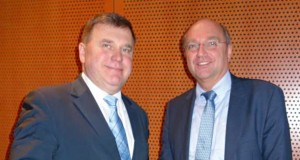On 4 March 2015 RAG submitted to the mining authorities a planning notification for the proposed increase in the mine water level in the Reden and Duhamel catchment areas. This marked the start of the approval procedure for phase I of the Saar Mine Water Drainage Concept. This provides for shutting down the Reden pumps and allowing the mine water level in the Reden area to rise by about 280 m from its current -600 m (below sea level) to -320 m in order to allow for an overflow into the Duhamel catchment area. At present the mine water from Reden flows into the Saar at Saargemünd via the Klinkenbach, Sinnerbach and Blies watercourses. Following implementation of phase I of the project these waterways would in future be free from mine water over a total distance of some 87 km. The mining authorities will now instigate a planning approval procedure, complete with environmental impact assessment and public consultation, in order to examine the effects that such measures will have on the local community and the environment. Phase I of the mine water concept can only be authorised provided there is no risk or danger posed by the proposed increase in mine water level. The approval process will last until 2016 at least. RAG intends to use the mine water drainage concept to meet its obligations under the Legacy Agreement for the long-term improvement of water drainage and management measures.
Mine water is created by rain water seeping into the ground and finding its way to lower levels via rock beds and fissures. Water flowing into mine shafts and underground roadways would normally make all mining operations impossible. For this reason collieries have to collect this water at a central point below ground, which is known as the sump, and then transfer it back up to the surface using a series of powerful pumps and a network of pipes. This operational requirement has no longer applied since mining operations in the Saar coalfield came to a halt.
RAG’s planning notification describes the project in every detail, along with any possible effects that it may have on man, cultural assets and property, soil, water, animals, plants and biodiversity, and on the landscape, climate and air. It also examines the interactions and interdependencies that exist between these protected resources.
If the mine water project is approved it will take more than three years for the water to rise by the proposed 280 m. At this point the mine water level will then still be some 500 m below the surface and so will be a sufficient distance away from the drinking water and groundwater horizons. RAG is taking nothing for granted and if, contrary to expectations, some degree of risk should appear, any further rise in the water level can be immediately halted at any time and at any height. RAG stresses that the protection of people and the environment takes clear precedence over any cost savings achieved through the discontinuance of pumping operations. And protecting drinking water in particular will take absolute priority over everything else.
The rise in mine water level provided-for in phase I is necessary simply to arrive at the initial situation, as assumed in the KPMG report, for calculating the eternity costs associated with dewatering and drainage measures in the German coal industry. Moreover, the parties to the Legacy Agreement, namely the RAG Foundation and the coalfield regions of North Rhine-Westphalia and Saarland, have engaged RAG to present new ideas for the ongoing long-term optimisation of water drainage that go beyond the KPMG report.
Phase II of the mine water drainage concept therefore provides for the closure of all remaining pumping facilities along the Saar river so that the level of the mine water can rise further until, in 2035, it reaches the surface at the lowest point in Ensdorf and so can be diverted into the Saar. This means that the Saar river would be completely free from mine water over a distance of some 40 km between Saargemünd and Ensdorf. Project phase II will therefore depend on a positive outcome from another independent planning approval procedure, complete with environmental impact assessment and public consultation.
At present, some 18 mill. m3 of mine water are pumped to the surface in the Saar coalfield every year. When all the pumps are operating together they consume as much electricity as 17,000 households. As RAG has pointed out, it is neither ecologically nor economically justifiable towards future generations to maintain these operations ‘in perpetuity’ unless there is an absolute operational requirement. (RAG AG/Si)
